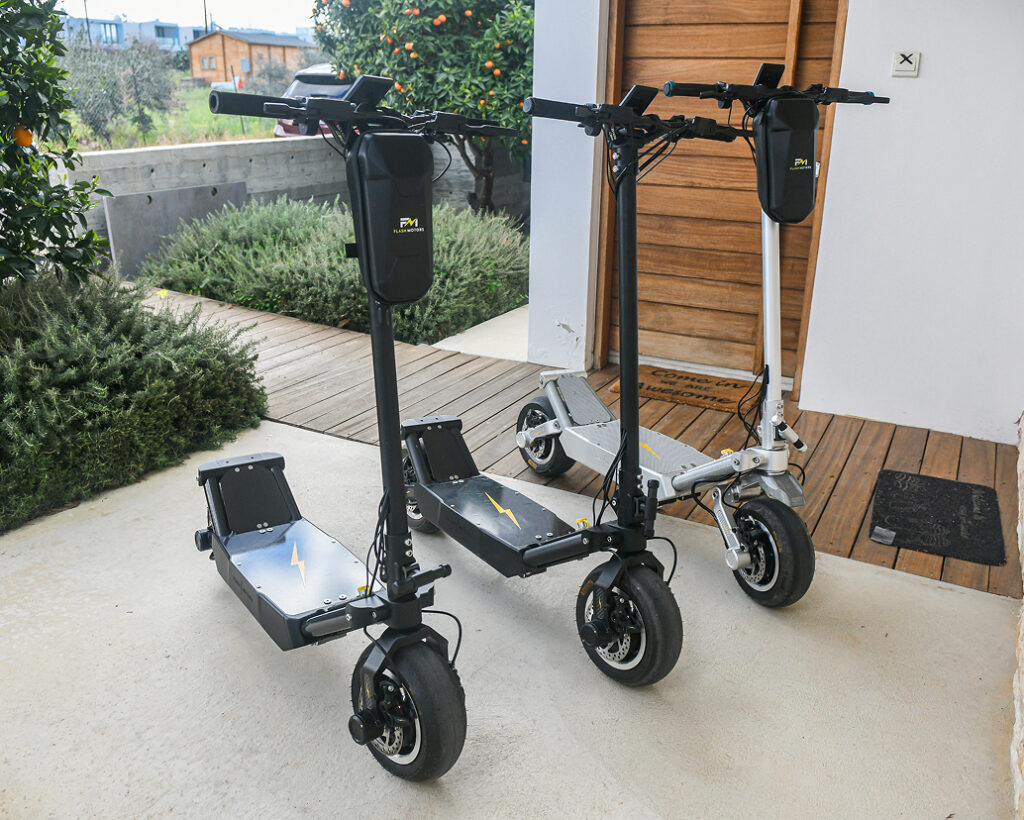
The longevity of electric scooters is a subject of great interest for both individual consumers and urban planners. As these efficient urban transportation modes continue to gain popularity, it becomes crucial to comprehend their lifespan to make informed decisions about purchases, maintenance, and urban mobility planning.
The average lifespan of an electric scooter is influenced by several pivotal factors. Firstly, the quality of the battery plays a crucial role. Higher quality batteries tend to last longer, offer more charge cycles, and provide more reliable performance. Regular maintenance, including timely servicing and repairs, is vital to extend the scooter’s lifespan. Additionally, riding habits and the conditions in which the scooter is used can significantly impact its longevity. Frequent usage, especially under harsh conditions like extreme weather or rough terrain, can accelerate wear and tear.
Understanding these factors is essential for maximizing the lifespan of an electric scooter, ensuring it remains a durable and efficient mode of transportation over time.
Battery life is a critical determinant in the overall lifespan of an electric scooter. The longevity and efficiency of a scooter largely depend on the health and performance of its battery. To maintain a healthy battery, it’s important to follow a few guidelines:
Regularly monitoring the scooter battery’s condition can help in the early detection of potential issues, thereby extending the scooter’s lifespan.
The longevity of an electric scooter is heavily influenced by its material and build quality. Scooters crafted from high-grade materials like aircraft-grade aluminum or reinforced carbon fiber tend to endure the rigors of frequent use better than those made from less durable substances. Consumers should look for sturdy frame materials, robust hinges, and quality finishes that resist wear and tear. The quality of the scooter’s critical components, such as its wheels, handlebars, and electronic parts, also plays a pivotal role. A well-built scooter should feel solid and stable, ensuring not just a longer lifespan but also safer rides.
Regular maintenance is crucial to make electric scooters last longer. This includes routinely checking and inflating tires to the recommended pressure, ensuring brakes are functioning correctly, and keeping the scooter clean to avoid dirt buildup in moving parts. Battery care is also vital. Avoid complete discharges and store the scooter in a dry, temperate environment. Periodically tightening loose bolts and screws can prevent wear and tear. Following the manufacturer’s maintenance guidelines helps keep the scooter in top condition for safe and prolonged use.
Environmental factors significantly impact the longevity of electric scooters. Exposure to extreme weather conditions like heavy rain, intense heat, or cold can deteriorate the scooter’s components, especially the battery and electrical systems. To mitigate these effects, store the scooter in a dry, climate-controlled environment when not in use. Avoid riding in harsh weather conditions whenever possible. If exposure to elements is inevitable, consider using protective covers and conduct regular inspections for any signs of weather-related damage. This proactive approach helps in preserving the scooter’s functionality and lifespan.
By understanding and effectively addressing these factors, both individual users and city planners can ensure the longevity and reliability of electric scooters, promoting their sustainable use as a modern mode of transportation.
Electric scooters have gained popularity as a convenient and environmentally friendly...
Introduction: Understanding the Debate The urban mobility landscape has been completely...
The transition to electric mobility is a revolution where phase speed...

72 Volts 30 Ah (2016Wh charge)
Equipped with a long-lasting battery for extended rides and adventures

Dual 3000W BLDC Hub Motors
Powerful dual-engine setup delivers dynamic performance for performance seekers

6 hours fast charging so you can spend less time waiting and more time exploring

110 km/h
Top-tier speed capabilities for the rush of wind and the thrill of pace

100 km
Ready for long journeys with a generous range that keeps you moving

120 kg
Robust build accommodates significant weight, ensuring a ride for all

Disk brake with dual 8 pistons (Front and Rear), E-Brake Included

PMT Italian Slick & Stradale 11-inch tubeless
High-quality tires designed for optimal traction and control in various conditions.

1230 mm
Streamlined design ensures a compact footprint for agile urban navigation.

1290 mm
Elevated stance provides a commanding view of the road ahead.

266 mm
Narrow build offers convenient maneuverability through tight spaces.

540 mm
Quick-fold mechanism reduces the scooter to a compact form for easy storage and portability.

Carbon fiber and CNC 6061 aluminum

IPX67-rated components

Optimized for minimal air resistance

Enjoy peace of mind with a comprehensive warranty covering your scooter

Complete with essential accessories, get everything you need to hit the road immediately

Two 150 AMP Nano Elite X5K
Precision control at your fingertips with advanced, customizable settings."

Choose from classic color options to match your style

72 Volts 30 Ah (2016Wh charge)
Equipped with a long-lasting battery for extended rides and adventures

Dual 3000W BLDC Hub Motors
Powerful dual-engine setup delivers dynamic performance for performance seekers

6 hours fast charging so you can spend less time waiting and more time exploring

110 km/h
Top-tier speed capabilities for the rush of wind and the thrill of pace

100 km
Ready for long journeys with a generous range that keeps you moving

120 kg
Robust build accommodates significant weight, ensuring a ride for all

Disk brake with dual 8 pistons (Front and Rear), E-Brake Included

PMT Slick Italian 11-inch
High-quality tires designed for optimal traction and control in various conditions.

1230 mm
Streamlined design ensures a compact footprint for agile urban navigation.

1290 mm
Elevated stance provides a commanding view of the road ahead.

266 mm
Narrow build offers convenient maneuverability through tight spaces.

540 mm
Quick-fold mechanism reduces the scooter to a compact form for easy storage and portability.

Carbon fiber and CNC 6061 aluminum

IPX67-rated components

Optimized for minimal air resistance

Enjoy peace of mind with a comprehensive warranty covering your scooter

Two 150 AMP Nano Elite X5K
Precision control at your fingertips with advanced, customizable settings."

Choose from classic color options to match your style

60 Volts 30 Ah (2016Wh charge)
Equipped with a long-lasting battery for extended rides and adventures

Dual 3000W BLDC Hub Motors
Powerful dual-engine setup delivers dynamic performance for performance seekers

6 hours fast charging so you can spend less time waiting and more time exploring

110 km/h
Top-tier speed capabilities for the rush of wind and the thrill of pace

100 km
Ready for long journeys with a generous range that keeps you moving

120 kg
Robust build accommodates significant weight, ensuring a ride for all

Disk brake with dual 8 pistons (Front and Rear), E-Brake Included

Front and Rear Single Absorbers
Smooth rides guaranteed with a suspension system that absorbs shocks and jolts

PMT Italian Stradale 11-inch tubeless
High-quality tires designed for optimal traction and control in various conditions.

1170 mm
Streamlined design ensures a compact footprint for agile urban navigation.

1250 mm
Elevated stance provides a commanding view of the road ahead.

241 mm
Narrow build offers convenient maneuverability through tight spaces.

470 mm
Quick-fold mechanism reduces the scooter to a compact form for easy storage and portability.

Carbon fiber and CNC 6061 aluminum

IPX67-rated components

Optimized for minimal air resistance

Enjoy peace of mind with a comprehensive warranty covering your scooter

Complete with essential accessories, get everything you need to hit the road immediately

Safety first with a helmet that combines comfort with protection

Two 150 AMP Nano Elite X5K
Precision control at your fingertips with advanced, customizable settings."

Choose from classic color options to match your style

60 Volts 30 Ah (2016Wh charge)
Equipped with a long-lasting battery for extended rides and adventures

Single 3000W BLDC Hub
Powerful dual-engine setup delivers dynamic performance for performance seekers

6 hours fast charging so you can spend less time waiting and more time exploring

100 km/h
Top-tier speed capabilities for the rush of wind and the thrill of pace

100 km
Ready for long journeys with a generous range that keeps you moving

120 kg
Robust build accommodates significant weight, ensuring a ride for all

Disk brake with dual 8 pistons (Front and Rear), E-Brake Included

Front and Rear Single Absorbers
Smooth rides guaranteed with a suspension system that absorbs shocks and jolts

PMT Italian Stradale 11-inch tubeless
High-quality tires designed for optimal traction and control in various conditions.

1170 mm
Streamlined design ensures a compact footprint for agile urban navigation.

1250 mm
Elevated stance provides a commanding view of the road ahead.

241 mm
Narrow build offers convenient maneuverability through tight spaces.

470 mm
Quick-fold mechanism reduces the scooter to a compact form for easy storage and portability.

Carbon fiber and CNC 6061 aluminum

IPX67-rated components

Optimized for minimal air resistance

Enjoy peace of mind with a comprehensive warranty covering your scooter

One 150 AMP Nano Elite X5K
Precision control at your fingertips with advanced, customizable settings."

Choose from classic color options to match your style
One of our specialists will be in touch within the next 24-48 hours to assist you. We appreciate your interest in our scooters and look forward to speaking with you soon!”

72 Volts 30 Ah (2016Wh charge)
Equipped with a long-lasting battery for extended rides and adventures

Dual 3000W BLDC Hub Motors
Powerful dual-engine setup delivers dynamic performance for performance seekers

6 hours fast charging so you can spend less time waiting and more time exploring

110 km/h
Top-tier speed capabilities for the rush of wind and the thrill of pace

100 km
Ready for long journeys with a generous range that keeps you moving

120 kg
Robust build accommodates significant weight, ensuring a ride for all

Disk brake with dual 8 pistons (Front and Rear), E-Brake Included

PMT Italian Slick & Stradale 11-inch tubeless
High-quality tires designed for optimal traction and control in various conditions.

1230 mm
Streamlined design ensures a compact footprint for agile urban navigation.

1290 mm
Elevated stance provides a commanding view of the road ahead.

266 mm
Narrow build offers convenient maneuverability through tight spaces.

540 mm
Quick-fold mechanism reduces the scooter to a compact form for easy storage and portability.

Carbon fiber and CNC 6061 aluminum

IPX67-rated components

Optimized for minimal air resistance

Enjoy peace of mind with a comprehensive warranty covering your scooter

Complete with essential accessories, get everything you need to hit the road immediately

Two 150 AMP Nano Elite X5K
Precision control at your fingertips with advanced, customizable settings."

Choose from classic color options to match your style

72 Volts 30 Ah (2016Wh charge)
Equipped with a long-lasting battery for extended rides and adventures

Dual 3000W BLDC Hub Motors
Powerful dual-engine setup delivers dynamic performance for performance seekers

6 hours fast charging so you can spend less time waiting and more time exploring

110 km/h
Top-tier speed capabilities for the rush of wind and the thrill of pace

100 km
Ready for long journeys with a generous range that keeps you moving

120 kg
Robust build accommodates significant weight, ensuring a ride for all

Disk brake with dual 8 pistons (Front and Rear), E-Brake Included

PMT Slick Italian 11-inch
High-quality tires designed for optimal traction and control in various conditions.

1230 mm
Streamlined design ensures a compact footprint for agile urban navigation.

1290 mm
Elevated stance provides a commanding view of the road ahead.

266 mm
Narrow build offers convenient maneuverability through tight spaces.

540 mm
Quick-fold mechanism reduces the scooter to a compact form for easy storage and portability.

Carbon fiber and CNC 6061 aluminum

IPX67-rated components

Optimized for minimal air resistance

Enjoy peace of mind with a comprehensive warranty covering your scooter

Two 150 AMP Nano Elite X5K
Precision control at your fingertips with advanced, customizable settings."

Choose from classic color options to match your style

60 Volts 30 Ah (2016Wh charge)
Equipped with a long-lasting battery for extended rides and adventures

Dual 3000W BLDC Hub Motors
Powerful dual-engine setup delivers dynamic performance for performance seekers

6 hours fast charging so you can spend less time waiting and more time exploring

110 km/h
Top-tier speed capabilities for the rush of wind and the thrill of pace

100 km
Ready for long journeys with a generous range that keeps you moving

120 kg
Robust build accommodates significant weight, ensuring a ride for all

Disk brake with dual 8 pistons (Front and Rear), E-Brake Included

Front and Rear Single Absorbers
Smooth rides guaranteed with a suspension system that absorbs shocks and jolts

PMT Italian Stradale 11-inch tubeless
High-quality tires designed for optimal traction and control in various conditions.

1170 mm
Streamlined design ensures a compact footprint for agile urban navigation.

1250 mm
Elevated stance provides a commanding view of the road ahead.

241 mm
Narrow build offers convenient maneuverability through tight spaces.

470 mm
Quick-fold mechanism reduces the scooter to a compact form for easy storage and portability.

Carbon fiber and CNC 6061 aluminum

IPX67-rated components

Optimized for minimal air resistance

Enjoy peace of mind with a comprehensive warranty covering your scooter

Complete with essential accessories, get everything you need to hit the road immediately

Safety first with a helmet that combines comfort with protection

Two 150 AMP Nano Elite X5K
Precision control at your fingertips with advanced, customizable settings."

Choose from classic color options to match your style

60 Volts 30 Ah (2016Wh charge)
Equipped with a long-lasting battery for extended rides and adventures

Single 3000W BLDC Hub
Powerful dual-engine setup delivers dynamic performance for performance seekers

6 hours fast charging so you can spend less time waiting and more time exploring

100 km/h
Top-tier speed capabilities for the rush of wind and the thrill of pace

100 km
Ready for long journeys with a generous range that keeps you moving

120 kg
Robust build accommodates significant weight, ensuring a ride for all

Disk brake with dual 8 pistons (Front and Rear), E-Brake Included

Front and Rear Single Absorbers
Smooth rides guaranteed with a suspension system that absorbs shocks and jolts

PMT Italian Stradale 11-inch tubeless
High-quality tires designed for optimal traction and control in various conditions.

1170 mm
Streamlined design ensures a compact footprint for agile urban navigation.

1250 mm
Elevated stance provides a commanding view of the road ahead.

241 mm
Narrow build offers convenient maneuverability through tight spaces.

470 mm
Quick-fold mechanism reduces the scooter to a compact form for easy storage and portability.

Carbon fiber and CNC 6061 aluminum

IPX67-rated components

Optimized for minimal air resistance

Enjoy peace of mind with a comprehensive warranty covering your scooter

One 150 AMP Nano Elite X5K
Precision control at your fingertips with advanced, customizable settings."

Choose from classic color options to match your style
I, hereby acknowledge that I have read, understood, and agree to be bound by the Terms and Service (“Terms”) outlined by Flashmotors LTD in relation to the purchase and use of their scooters. By accepting these Terms, I affirm that I am of legal age and possess the necessary authority to enter into this agreement.
I specifically acknowledge and agree to the following:
1. Legal Notice: I am aware that the scooters provided by Flashmotors LTD are intended for personal use and must be operated in compliance with all applicable laws and regulations of Cyprus.
2. Withdrawal, Return, Refund, and Cancellation Policy: I understand that as per Cyprus law, I have the right to withdraw from the purchase contract within 14 days of receiving the Product. I agree to follow the specified procedures regarding withdrawal, return, and refund, including returning the Product in its original condition.
4. Complaint Policy: In the event of any issues or concerns with the Product, I agree to promptly contact the customer service team of Flashmotors LTD providing necessary information to assist in resolving the complaint.
5. Liabilities under Cyprus Law: I acknowledge that any liability or obligation arising from these Terms is subject to the laws and regulations of Cyprus. I understand that any dispute related to these Terms shall be subject to the exclusive jurisdiction of the courts of Cyprus.
6. Acceptance of Communication Terms: By providing your contact information and checking the designated boxes during account registration, or by entering your contact details on Flashmotors.com, you expressly consent to receive promotional and informational communications via SMS and email from Flashmotors.
I further acknowledge that Flashmotors LTD reserves the right to modify or update these Terms at any time, with the revised Terms becoming effective immediately upon posting on their website.
By accepting these Terms and Conditions, I confirm that I have reviewed and understood all the provisions contained therein, and I agree to be bound by them in their entirety.